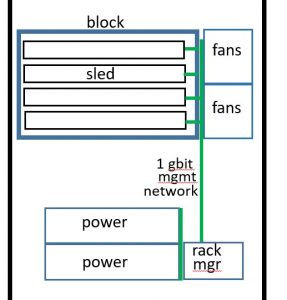
Organizations that are growing at rates requiring truly large scale infrastructure, in addition to their immediate growth needs, should be seriously considering how the infrastructure they are creating will sustain itself over time. Answering your short term growth pressures without also addressing the need to manage larger and larger infrastructure is not an approach that will have a happy ending.
 When we designed the DSS 9000 rack scale solution we understood that – because we have more than a decade of deep experience with the leaders in hyperscale computing. Scale comes with its own set of challenges, and foremost among them is management. How do you manage exponentially expanding infrastructure without losing the advantages that scale delivers?
When we designed the DSS 9000 rack scale solution we understood that – because we have more than a decade of deep experience with the leaders in hyperscale computing. Scale comes with its own set of challenges, and foremost among them is management. How do you manage exponentially expanding infrastructure without losing the advantages that scale delivers?
The answer is that you need to have an architecture that allows you to easily incorporate and adopt the technologies that are being developed to address the latest challenges in the industry. Being an open architecture allows the DSS 9000 to benefit from the work being done across the entire industry to more efficiently manage massive data centers.
The promise of fully composable infrastructure is management nirvana for large scale environments; it’s the point when all resources – compute, storage, networking, memory – are fully disaggregated across the infrastructure and available to be independently “composed” into whatever infrastructure combinations you need. While the technology has not quite caught up with the dream yet (see the recent blog by Robert Hormuth, CTO of the Dell EMC Infrastructure Solutions Group), the DSS 9000 offers composable elements in its current version and a path to full composability in the future.

Manage at the Rack Level
Efficient, open and agile rack management is at the design core of the DSS 9000. Its management foundation is based on the industry accepted Redfish management APIs. The Intel ® Rack Scale Design (RSD) hardware resource manager also uses the Redfish open APIs as its foundation and this allows the DSS 9000 to implement RSD’s Pooled System Management Engine (PSME) APIs and firmware as part of its Rack Manager component to enable the comprehensive inventory of all devices in the rack. It is this leveraging of open management APIs and software that lets the DSS 9000 provide a single management interface across the rack and consolidate rack-wide operations, for example, to perform firmware updates to all the devices in the rack at once. Imagine the overall reduction in time consumed (and money saved) that this adds up to across massive infrastructure environments. Redfish compatibility is also what makes it possible to support ancillary third party gear like switches and servers within a DSS 9000 rack, permitting even greater choice and functionality for customers.
Dynamically Allocate Resources Across the Rack
The disaggregation of resources provided by Redfish and Rack Scale Design are the beginning steps on the path to full composability. Using integration software from Dell EMC and an orchestration tool (i.e., MAAS, OpenStack Fuel) compute and storage resources on the DSS 9000 can be dynamically allocated across the rack as needed. (See the Transforming Management for Modern Scale-Out whitepaper for details.) The ability to allocate and subsequently decommission resources on the fly gives data centers tremendous flexibility in how they choose to run their day-to-day operations. It allows for higher levels of resource utilization and the ability to respond more rapidly to spikes in demand.
Deploy Racks at a Time
 The DSS 9000 is delivered as a pre-integrated rack after being built to customers’ specifications. The server and storage sleds that make up the rack, have a wide range of optional components that give customers tremendous flexibility to optimize for their specific workloads. When the racks are delivered it is as simple as rolling them into place, plugging them in and beginning to provision the systems – no additional cabling or integration of the racks. The building-block chassis structure of the DSS 9000 also makes it quick and easy to scale within a rack, by simply sliding in a fully populated chassis.
The DSS 9000 is delivered as a pre-integrated rack after being built to customers’ specifications. The server and storage sleds that make up the rack, have a wide range of optional components that give customers tremendous flexibility to optimize for their specific workloads. When the racks are delivered it is as simple as rolling them into place, plugging them in and beginning to provision the systems – no additional cabling or integration of the racks. The building-block chassis structure of the DSS 9000 also makes it quick and easy to scale within a rack, by simply sliding in a fully populated chassis.
Benefit From Rack Scale Design
The DSS 9000 design includes a powerful rack management infrastructure. It has a separate Intel® Atom powered Rack Manager component that is connected to each of the block chassis and, in turn, to each individual server. Status and control of servers, power, and cooling are communicated through a gigabit management network that is independent of the data network. This infrastructure enables faster communication and more extensive management functionality for the increasingly complex workloads service providers and carriers now provide. In addition, it permits independent control at the block level for more efficient power and cooling.
Transform Large Scale Management
To remain competitive as they scale, organizations need to invest in infrastructure with the ability to adopt new technologies quickly, to take advantage of open platforms and to move toward full composability. The DSS 9000 is infrastructure that helps organizations into a more productive and efficient future. See the DSS 9000 Rack Management video for more details and a look at the DSS 9000 in action.